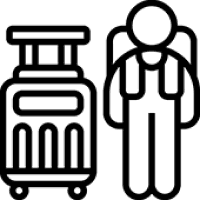EAC and Tourism & Wildlife Management
East Africa has recorded impressive achievements in the realm of tourism owing to the conscious efforts by EAC Partner States to work together in promoting growth in the sector. The tourism sector contributes an average of about 17% to export earnings and makes a substantial contribution to the GDP averaging at around 9.5%. It generates about 7% of employment in the region. The success of the tourism sector has benefited from immense private sector investments in hotels, transportation, marketing and product development, and dedicated government efforts in conservation. One of the priorities of the EAC is promoting its Partner States as a single destination, where tourists can visit various sites across EAC Partner States easily and cheaply through a single multi-entry visa system thereby creating benefits across the region for the tourism sector. In addition, Partner States have agreed on joint promotion of tourist attraction sites, the adoption of EAC preferential rates for EAC citizens, which are applicable to public tourist sites such as parks and museums, and harmonisation of criteria for Hotels as well as other accommodation establishments. EAC activities are guided by the EAC Tourism Marketing Strategy that was adopted by Partner States in 2021.
The German Government supports this EAC Sector under Core Area 1 of EAC-German cooperation as defined by BMZ 2030 – “Sustainable Economic Development, Training and Employment” in the Intervention Area of “Socially and Environmentally Sound Supply Chains, Trade and Sustainable Infrastructure”. The cooperation directly contributes to implement two of the eight priority areas defined by the 6th EAC Development Strategy, namely “Strengthening Productive and Social Sectors” and “Awareness Creation”. The BMZ 2030 reform strategy focuses on a new quality of cooperation. More information on BMZ 2030 can be found here.

Tourism & Wildlife
EAC-Germany Support

Tourism Promotion & Marketing
The EAC and Partner States have developed and are currently implementing the EAC Tourism Marketing Strategy (2021-2025), which envisions the EAC region to be the leading sustainable tourism destination in Africa. The strategy emphasizes developing multi-destination regional tourism products that will be marketed to intra-regional and international markets. In line with this, the EAC has developed the “Visit East Africa – Feel the Vibe” brand that considers the Partner States’ unique identities and distinctiveness to attract visitors from the region and globally.Projects:
SEAMPEC II (GIZ)
Objective: Positioning and marketing the EAC as a leading regional and global single tourism destination in Africa to increase visitations to key tourist sites and consumption of tourism services by regional and international markets.
Approach: SEAMPEC II, together with the EAC, and in close collaboration with the East African Tourism Platform (EATP), have undertaken various initiatives to promote regional and global tourism through the implementation of activities guided by the EAC Tourism Marketing Strategy. Regional marketing campaigns have been developed and implemented which call upon East Africans to visit their region. Additionally, a global brand promoting the EAC region has been established to attract more visitors from the whole globe. Sensitisation and capacity building of the respective private sector stakeholders regarding product development and tourism marketing have been implemented to support the implementation of the Marketing Strategy.
The following achievements are realised under the SEAMPEC II programme,
Activities include:
- Developing a global EAC tourism destination brand, “Visit East Africa – Feel the Vibe.”
- Increasing awareness among EAC citizens of signature products and experiences by promoting the EAC region: production and distribution of promotional videos i.e., the Tembea Nyumbani video, support to promotional activities of EATP.
- Development of an e-Catalogue for EAC preferential rates.
- Promoting the EAC region by participating in annual regional and national tourism fairs.
- Facilitating exchange with other RECs on domestic and regional tourism.
- Enhancing capacity of EAC Tourism private sector stakeholders including services providers, local communities, women, and youth.
Find more information on SEAMPEC II here.
Building on these achievements, follow-on tourism interventions are now being implemented under the LIFTED programme.
LIFTED (GIZ)
Objective: Positioning and marketing the EAC as a leading regional and global single tourism destination in Africa to increase visitations to key tourist sites and consumption of tourism services by regional and international markets.
Approach: LIFTED, together with the EAC, undertake various initiatives to promote tourism regionally and globally as guided by the EAC Tourism Marketing Strategy. These include joint participation in the regional and international tourism fairs, fostering engagement and partnerships between EAC-based tourism stakeholders with EU-based tourism stakeholders, and implementation of the EAC Single Tourism Destination Brand “Visit East Africa – Feel the Vibe," including associated sensitisation and capacity development of both public and private sector stakeholders on the usage and application of the brand in collaboration with the selected brand champions from the EAC Partner States.
Activities include:
- Promoting the EAC region by participating in annual regional and international tourism fairs.
- Conducting outreach and visibility campaigns to promote the “Visit East Africa – Feel the Vibe" brand.
- Developing signature products, such as promotional videos that highlight the unique identities of each Partner State, packaged together as a single destination under the EAC brand.
- Capacity development for the public and private sector on implementation of the “Visit East Africa – Feel the Vibe" brand and digital tourism marketing as per the brand's communication plan.
Find more information on LIFTED here.

Cross-Border Tourism
Tourism is a key income stream for EAC Partner States. Hence, building the industry and creating benefits for tourism operators and citizens within the Common Market has been a focus for the EAC. Efforts undertaken in this regard include market access for EAC Tourism Services providers without discrimination based on nationality as well as harmonising the standards in the region, i.e., by developing common criteria for the classification of tourist accommodation establishments and restaurants. This guarantees a quality standard and predictability in the expected quality of service in the region. However, there is a need to promote more cooperation and collaboration to exploit the regional potential, as well as resource sharing and joint efforts for resource conservation. Tour operators should therefore be able to move and provide their services in the region without cumbersome barriers and be able to utilise and leverage on the available potential the region has to offer.Projects:
SEAMPEC II (GIZ)
Objective: Develop joint proposals to remove barriers and restrictions for EAC tour operators for provision of services in the EAC region.
Approach: SEAMPEC II facilitates the free movement of tourism services and services providers through the removal of barriers and restrictions such as registration requirements for tour operators and tour guides.
The following achievements are realised under the SEAMPEC II programme,
Activities include:
- Adoption of minimum standards for the tourism sector including licensing and registration for selected categories such as tour operators and tour guides.
- Review of the EAC classification criteria for tourism accommodation establishments and restaurants.
- Development of a Regional Tourism Barometer to enable better decisions and gauge the effectiveness of policies, strategies, actions and leadership as it pertains to tourism development.
- Capacity development for selected ministries, agencies and operators in the Tourism Sector.
Find more information on SEAMPEC II here.
Building on these achievements, follow-on tourism interventions are now being implemented under the LIFTED programme.
LIFTED (GIZ)
Objective: Harmonisation of the Tourism Operating Requirements across the EAC region by simplifying, streamlining, and standardising the process for obtaining and maintaining tourism-related operating licenses.
Approach: LIFTED facilitates the free movement of tourism services and service providers through the harmonisation of operating licensing requirements for tour operators, travel agencies, tour guides, and tourism accommodation establishments and restaurants. Additionally, the harmonisation of operating licensing requirements will pave the way for the establishment of the prerequisites of the Mutual Recognition Agreement (MRA) within EAC. These activities will facilitate the free movement of tourism service providers, in line with Partner States commitments under the CMP.
Activities include:
- Targeted support, including advocacy campaigns towards the removal of identified restrictions of transboundary nature.
- Conducting a study to guide on the framework for harmonisation of operating requirements of regional tour operators, travel agencies, tourism accommodation establishments, tour guides, etc. for cross-border tourism.
- Conducting a diagnostic baseline on mobility barriers for tourism-related professions.
Find more information on LIFTED here.

Capacity Development of Tourism Stakeholders
As part of the interventions to support the tourism sector, the EAC aims to strengthen institutional and private sector capacity to jointly develop and market the region as a single tourism destination. In this regard, the EAC has officially launched a state-of-the-art e-learning programme to foster capacity development in the tourism sector. The EAC Online Tourism Capacity Development Programme, hosted on the atingi e-learning platform, aims to upscale the skills and competencies of tourism stakeholders in the region, including those of different service providers, MSMEs, youth, women, and local communities, among other stakeholders and practitioners. The EAC is leveraging digital platforms and reaching people in their homes and places of work in all the EAC Partner States.
Projects:
LIFTED (GIZ)
Objective: Developing skills and knowledge for tourism-related stakeholders to be able to offer professional tourism services supportive of growth and enhancing their employability.
Approach: LIFTED supports the EAC, through the EAC Online Tourism Capacity Development Programme, in strengthening the skills of tourism-related stakeholders across the region with a focus on providing locally tailored and relevant learning opportunities. This is done through a blended learning concept where learners have access to varying self-paced courses, i.e., tourism marketing and tour guiding, as well as additional course materials such as joint webinars, expert talks, and peer-to-peer learning through discussion forums.
Activities include:
- Implementing capacity development via the programme on the atingi e-learning platform, focusing on a blended learning approach.
- Undertaking awareness and sensitisation initiatives for the programme to enhance outreach.
- Developing additional courses, such as on minimum standards or classification criteria, as part of the programme.
Find more information on the EAC Online Tourism Capacity Development Programme here.
Find more information on LIFTED here.